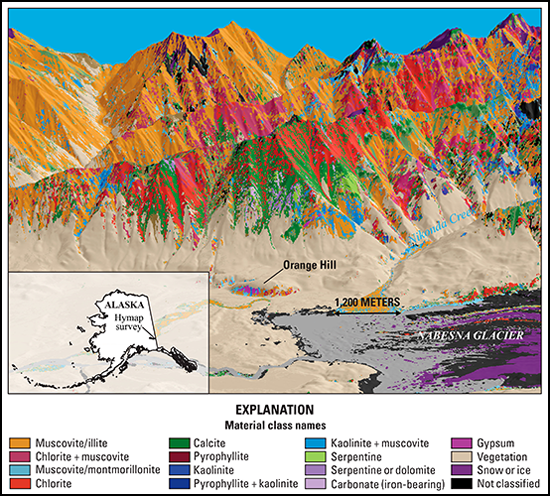Researchers are experimenting with a spectroscopic method in Alaska to explore remote regions of the state for undiscovered deposits of copper and other resources. By using a technique called hyperspectral surveying from aircraft to find the mineral muscovite, the scientists are assessing whether they can find copper from a distance.
“We wanted to push the application of the technology” in jagged terrain that poses challenges for aiming and aligning sensors and other equipment, said Raymond Kokaly, a research geophysicist at the U.S. Geological Survey (USGS) Crustal Geophysics and Geochemistry Science Center in Denver, Colo., and lead author on the study and a new fact sheet about the work.
Hyperspectral imaging is a well-established technique. It works by measuring the various wavelengths of light that bounce off of a material. By observing the different wavelengths, scientists can reveal the chemical composition of rocks. This allows them to build up a picture of a hillside’s geology from a distance.
Clues to Copper

Using airborne instruments—the preferred method of collecting data in remote, difficult-to-access parts of the world—Kokaly and his team gathered hyperspectral information from Alaskan slopes. They were investigating whether they could successfully identify mineral deposits from a distance.
Specifically, they sought a copper ore called porphyry, which is hard to spot with spectroscopy but is known to be associated with the presence of easily observed muscovite. Their idea was to develop a hyperspectral “fingerprint” for copper based on what airborne surveys could observe about muscovite nearby.
After 2 days of flying over mountain slopes, the team had covered more than 1900 square kilometers and mapped locations where muscovite was present in various quantities and forms. The USGS team then worked with colleagues from the Alaska Division of Geological and Geophysical Surveys, the University of Alaska Fairbanks, and the National Park Service to confirm results on the ground. The researchers then overlaid locations of known copper deposits on their map, looking for patterns in the wavelengths of light reflected back to the receiver. Sure enough, the densest muscovite deposits they detected were strongly associated with the known copper concentrations.
The team’s work is preliminary, but if they can prove that it works reliably, similar techniques might help researchers find other minerals, including gold and silver, Kokaly said.
—Elizabeth Deatrick, Freelance Science Journalist; email: [email protected]
